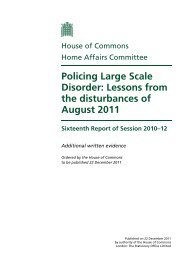Murder and Serious Sexual Assault - Lancaster EPrints - Lancaster ...
Murder and Serious Sexual Assault - Lancaster EPrints - Lancaster ...
Murder and Serious Sexual Assault - Lancaster EPrints - Lancaster ...
Create successful ePaper yourself
Turn your PDF publications into a flip-book with our unique Google optimized e-Paper software.
SUMMARY AND CONCLUSIONS<br />
Applying the results<br />
What can risk assessment professionals <strong>and</strong> other agencies take away from these<br />
findings? The analyses illustrate risk in terms of how much more likely certain<br />
offenders (those who possess certain types of previous convictions) are to be<br />
convicted of murder or SSA, compared with other offenders. Although many of the<br />
relative risks are statistically significant, the extent to which they are useful for<br />
practitioners working in real world settings may at first seem more restricted. A<br />
good number of these findings indicate that many categories of conviction carry<br />
only a slightly enhanced risk of subsequent serious offending (greater than one, but<br />
less than twice as likely to receive a subsequent conviction for murder or a serious<br />
sexual offence than a general offender).<br />
For example, knowing that a person with a conviction for robbery or assaults with<br />
intent is just over one <strong>and</strong> a half times as likely to be convicted for SSA compared<br />
with an offender who has no such convictions is of limited value to practitioners<br />
(despite the fact that it is a statistically significant result). Principally this is<br />
because, in spite of increased risk due to the presence of certain previous<br />
convictions, the vast majority of the many offenders with these convictions do not<br />
go on to commit serious offences.<br />
Even for those ‘unusual’ previous convictions that indicate a relatively high<br />
likelihood of future conviction for a more serious offence, the absolute risk of<br />
offending seems low. In other words, the likelihood that one particular offender with<br />
a high risk conviction will go on to commit a target offence is low; for example,<br />
robbery had a relative risk of 2.27, but the absolute risk of someone with this offence<br />
going on to be convicted of murder is low, at around one in 526 (see Appendix B).<br />
There are, nevertheless, several very practical applications arising from this study.<br />
As other commentators have observed, the present trend is towards a more<br />
preventative approach to serious offending, with the introduction of measures<br />
designed primarily to protect the public (Maguire, Kemshall, Noakes, Wincup <strong>and</strong><br />
Sharpe, 2001). Examples of recent legislative provisions to effectively manage<br />
offenders in the community include the introduction of the sex offender register<br />
under the Sex Offenders Act 1997, <strong>and</strong> the use of Sex Offender Orders under the<br />
Crime <strong>and</strong> Disorder Act 1998 (Kemshall, 2001). Several of these approaches benefit<br />
by being informed from this study, <strong>and</strong> in particular, that we can make more<br />
informed judgements about broad groups of offenders whose criminal convictions<br />
suggest higher levels of relative risk of future serious offending.<br />
42
















